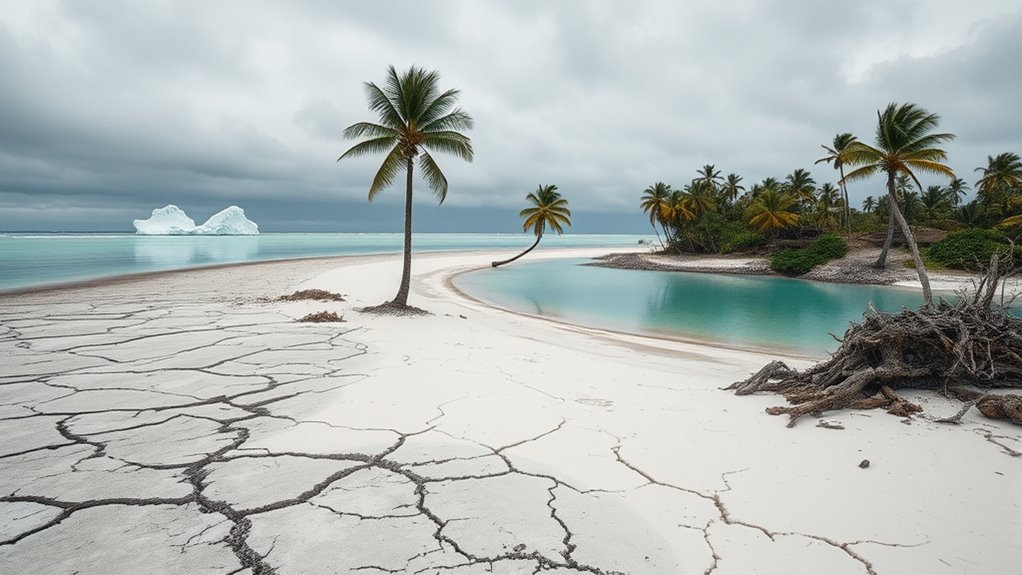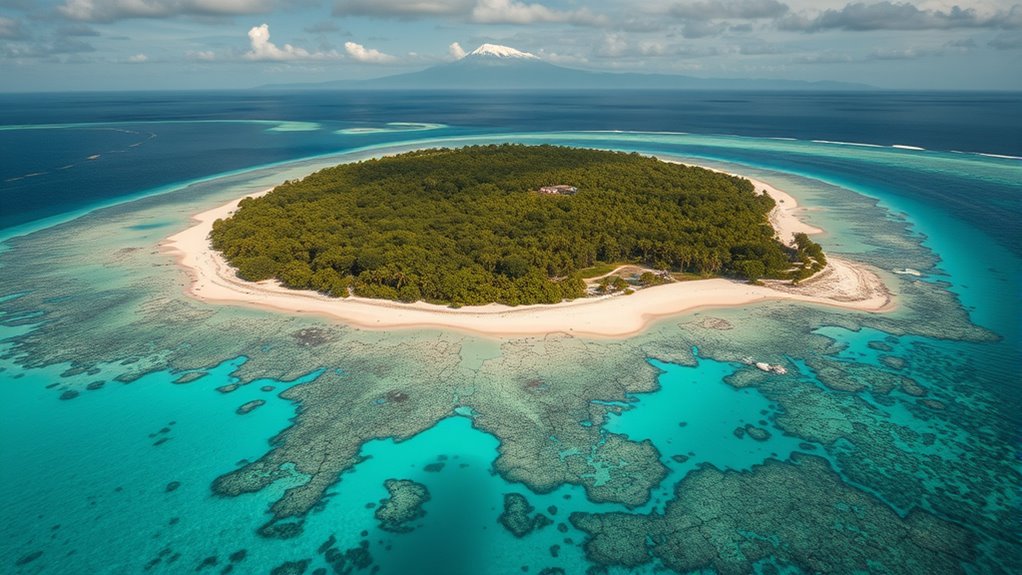Climate change is dramatically impacting travel destinations by causing more extreme weather, rising sea levels, and ecosystem damage. You might notice natural wonders like coral reefs and beaches deteriorate or become inaccessible. Travelers now prefer destinations that are resilient and eco-friendly, often avoiding places prone to floods, wildfires, or heatwaves. As these changes accelerate, understanding how climate affects your travel choices becomes essential—continue exploring to discover how to adapt and plan smarter trips.
Key Takeaways
- Travelers are shifting preferences toward cooler, less crowded, and more resilient destinations due to rising temperatures and unpredictable weather patterns.
- Rising sea levels threaten coastal cities and beaches, risking displacement and economic losses in tourism-dependent regions.
- Environmental degradation of natural attractions like coral reefs diminishes their appeal and causes shifts toward “last chance tourism.”
- The tourism industry faces increased pressure to adopt sustainable practices to reduce emissions and adapt to climate-related challenges.
- Extreme weather events such as storms, floods, and wildfires are disrupting travel plans and damaging infrastructure at various destinations.

Have you noticed how climate change is reshaping the way we travel? It’s no longer just about choosing a destination; it’s about steering through a landscape transformed by rising temperatures, unpredictable weather, and environmental degradation. As the planet warms, more travelers are intentionally avoiding peak seasons to escape heatwaves, with over 20% of Europeans planning to shift their travel plans in 2025. They’re also steering clear of areas prone to extreme weather like storms, floods, and wildfires, which are becoming more frequent and intense. Instead, many are seeking relief in colder destinations, leading to a rise in “coolcations”—searches for winter escapes that offer respite from summer heat. This shift impacts not only travel preferences but also the timing and location of trips, as travelers adapt to a changing climate.
Climate change is prompting travelers to avoid peak seasons and seek cooler destinations worldwide.
Meanwhile, the environmental footprint of tourism continues to grow. Projections show that tourism emissions could reach 6.5 billion metric tons by 2025—a 44% increase since 2013. From 2009 to 2019, emissions jumped by 40%, making tourism responsible for nearly 9% of global greenhouse gases. The aviation sector plays a significant role, accounting for around 4% of all emissions, and the rapid recovery of travel after COVID-19 has pushed these numbers back to pre-pandemic levels. This rapid rebound underscores the urgent need for sustainable practices in the industry. The increasing carbon footprint puts pressure on destinations and governments alike to find ways to reduce their environmental impact. Carbon emissions from tourism are rising rapidly, highlighting the importance of adopting greener transportation and sustainable tourism practices. Additionally, the climate resilience of destinations is becoming a key factor for travelers when choosing where to visit, as they seek places better equipped to handle environmental changes. Growing awareness of climate adaptation strategies is encouraging destinations to implement measures that protect their environments and economies. Moreover, the development of renewable energy sources within tourist regions can help mitigate some of the industry’s environmental impact, encouraging sustainable growth.
Sea level rise presents a dire threat to many popular travel spots, especially coastal cities and island nations. By 2050, sea levels could increase by about a foot, flooding cities like Jakarta and Rotterdam, which are already implementing measures such as seawalls and mangrove planting to combat erosion. Small island nations like the Maldives and Seychelles depend heavily on tourism—over 50% of their exports come from it—and face existential threats from flooding and tropical storms. As these environments become less hospitable, beach tourism declines, risking the economies built on coastal attractions and fragile ecosystems. Rising sea levels threaten to displace entire communities and reshape coastlines, further impacting tourism-dependent economies.
Growing awareness of climate threats is shaping travelers’ choices. Over 80% of global travelers in 2024 value sustainable travel options, with many motivated by ethical concerns. Travelers see industry providers as key to reducing tourism’s climate impact but also believe personal responsibility matters. This awareness is pushing the industry to adopt sustainable practices before environmental changes make travel unfeasible. Sadly, environmental degradation, like coral bleaching and ocean heating, ruins once-thriving attractions such as the Great Barrier Reef. As natural sites weaken or vanish, travel patterns shift—sometimes dangerously—leading to phenomena like “last chance tourism,” which risks further damaging already fragile ecosystems. In this way, climate change is not only altering where we go but also how we experience the world.
Frequently Asked Questions
How Are Local Communities Adapting to Climate-Induced Changes?
You see that local communities are actively adapting to climate-induced changes through community-based tourism. They’re investing in sustainable practices, conserving ecosystems, and engaging in participatory planning. By involving locals in decision-making, they boost resilience, preserve cultural heritage, and generate funds for climate projects. Educational workshops and collaborative efforts also raise awareness, empowering communities to implement innovative solutions that protect both their environment and livelihoods.
What Are Some Emerging Eco-Friendly Travel Destinations?
You’re in for a treat exploring emerging eco-friendly destinations. Costa Rica offers lush rainforests and beaches with sustainable lodges. Norway features emission-free fjord cruises, while New Zealand showcases geothermal wonders. Bhutan, the world’s first carbon-negative country, emphasizes cultural preservation and eco-tourism. Spain is innovating with circular tourism models. These destinations are paving the way for responsible travel, proving that green choices can truly make a difference in how you experience the world.
How Does Climate Change Affect Travel Insurance Policies?
Climate change impacts your travel insurance policies by making them more all-encompassing and costly. Insurers respond to increased risks from extreme weather by raising premiums, revising coverage, and excluding certain climate-related damages. They also update policies to include trip cancellations due to events like wildfires or storms. You’ll find more emphasis on emergency assistance, health coverage, and disclosures, all aimed at managing the rising financial and health risks associated with climate change during your travels.
Are There Specific Seasons Becoming Unfavorable for Travel?
You’ll find that summer is becoming less favorable for travel due to increasing heat waves, wildfires, and extreme weather, making destinations like Greece and Italy less appealing. Instead, autumn and spring are gaining popularity as travelers seek cooler, more comfortable times to visit. This shift is driven by rising temperatures, prompting you to contemplate traveling during shoulder seasons or exploring cooler destinations to avoid the risks of summer heat.
How Can Travelers Minimize Their Carbon Footprint Effectively?
Imagine you’re a modern-day explorer, like a travel pirate, seeking eco-friendly ways to minimize your carbon footprint. You can choose sustainable accommodations with eco-certifications, use public transport or rent eco-friendly vehicles, and opt for non-flying options like trains. Also, reduce waste by packing reusable items, eat local cuisine, and support community projects. These actions help protect the planet, making your adventures responsible and impactful.
Conclusion
As you plan your future travels, remember that climate change isn’t just a distant threat; it’s reshaping the destinations you love. While some places offer warmer winters and longer seasons, others face rising seas and vanishing beaches. Your choices now can help preserve these wonders or accelerate their decline. Traveling responsibly becomes a act of hope and awareness—an opportunity to enjoy the world’s beauty while protecting it from the very changes that threaten to erase it.









